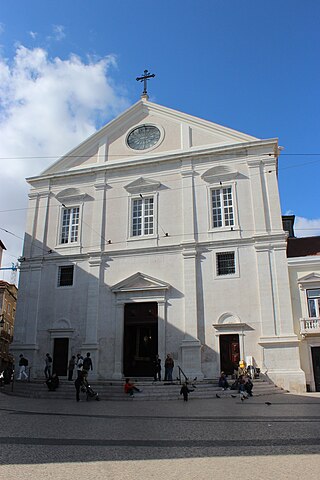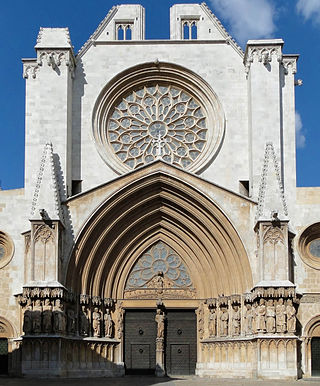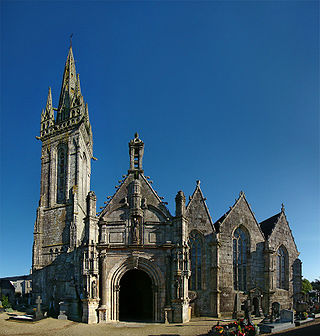
The Church of the Gesù is the mother church of the Society of Jesus (Jesuits), a Catholic religious order. Officially named Chiesa del Santissimo Nome di Gesù, its façade is "the first truly baroque façade", introducing the baroque style into architecture. The church served as a model for innumerable Jesuit churches all over the world, especially in the central Europe and then in the Portuguese colonies. Its paintings in the nave, crossing, and side chapels became models for Jesuit churches throughout Italy and Europe, as well as those of other orders. The Church of the Gesù is located in the Piazza del Gesù in Rome and is one of the great 17th century preaching churches built by Counter-Reformation orders in the Centro Storico.

St Francis Xavier's Church is a Roman Catholic church in Salisbury Street, Everton, Liverpool, Merseyside, England. The church is recorded in the National Heritage List for England as a designated Grade II* listed building. It is an active parish church in the Archdiocese of Liverpool and the Pastoral Area of Liverpool North.

The Church of Saint Andrew on the Quirinal is a Roman Catholic titular church in Rome, Italy, built for the Jesuit seminary on the Quirinal Hill.

The Basilica of Bom Jesus is a Catholic basilica located in Goa, in the Konkan region of India. The iconic church is a pilgrimage centre and recognised by UNESCO as a World Heritage Site. The basilica is located in Old Goa, the former capital of Portuguese India, and holds the mortal remains of St Francis Xavier.

San Felipe de Neri Church is a historic Catholic church located on the north side of Old Town Plaza in Albuquerque, New Mexico. Built in 1793, it is one of the oldest surviving buildings in the city and the only building in Old Town proven to date to the Spanish colonial period. The church is listed on the New Mexico State Register of Cultural Properties and the National Register of Historic Places and has remained in continuous use for over 200 years.

San Thome Church, officially known as St Thomas Cathedral Basilica and National Shrine of Saint Thomas, is a minor basilica of the Catholic Church in India, at the Santhome neighbourhood of Chennai, in Tamil Nadu. The present structure dates back to 1523 AD, when it was built by the Portuguese over the tomb of Thomas the Apostle. In 1896, it was renovated in the Madras province according to neo-Gothic designs, as was favoured by British architects in the late 19th century.

De Krijtberg Kerk is a Roman Catholic church in Amsterdam, located at the Singel. The church was designed by Alfred Tepe and was opened in 1883. The exuberant interior was made by Friedrich Wilhelm Mengelberg.

The Igreja de São Roque is a Catholic church in Lisbon, Portugal. It was the earliest Jesuit church in the Portuguese world, and one of the first Jesuit churches anywhere. The edifice served as the Society's home church in Portugal for over 200 years, before the Jesuits were expelled from that country. After the 1755 Lisbon earthquake, the church and its ancillary residence were given to the Lisbon Holy House of Mercy to replace their church and headquarters which had been destroyed. It remains a part of the Holy House of Mercy today, one of its many heritage buildings.

The Primatial Cathedral of Tarragona is a Roman Catholic church in Tarragona, Catalonia, Spain. The edifice is located in a site previously occupied by a Roman temple dating to the time of Tiberius, a Visigothic cathedral, and a Moorish mosque. It was declared a national monument in 1905.

The St. Francis Xavier Church in the Downtown district of Missoula, Montana, is the tallest church in Missoula, and one of the tallest in the state. It is also the tallest church in Missoula County, Montana. It has paintings well over 100 years old, which were done by a brother of the Society of Jesus, a kitchen helper, who painted them in his spare time. It is located at 420 West Pine Street.

The church of Santa Maria Assunta, known as I Gesuiti, is a religious building in Venice, Italy. It is located in the sestiere of Cannaregio, in Campo dei Gesuiti, not far from the Fondamenta Nuove.

The Abbey Church of St Leonard of Old Warden is a Grade I listed church in Old Warden, Bedfordshire, England. It became a listed building on 31 October 1966.

St Peter Canisius Church, also known as Molenstraatkerk, is a Roman Catholic Parish church in Nijmegen, Gelderland, Netherlands. It is situated on Molenstraat in the centre of the city. It is run by the Society of Jesus and is in the Diocese of 's-Hertogenbosch. It is built on the site of a 14th-century monastery, which was passed into the hands of the Jesuits in 1818. It was rebuilt in 1896 and again in 1960 after being bombed in the Second World War.

The Bodilis Parish close of Bodilis is located in the arrondissement of Morlaix in Finistère department of Brittany in north-western France. Apart from the parish church, the Église Notre-Dame, the enclosure at Bodilis includes a perimeter wall with three entrance gates and a simple crucifixion cross. The ossuary was destroyed in 1825. The church is a listed historical monument since 1910. The choir and central nave date to 1567 and the bell tower was added in 1570. The porch was added in 1601 and the sacristy in 1682. From the beginning of the 16th century, Bodilis' burgeoning linen industry boosted the town's wealth. An important fair was staged there and there were frequent pilgrimages to the town to secure "pardons" from the Virgin Mary. Much of the wealth generated was channeled into enhancing the parish church and, as a result, it shows elements of Gothic, Renaissance, Classical and Baroque styles. The bell tower porch is of the late Gothic style and is forty metres high. The church also has a 1564 chevet built in the Beaumanoir style.

Churches and Convents of Goa is the name given by UNESCO to a set of religious monuments located in Goa Velha, in the state of Goa, India, which were declared a World Heritage Site in 1986.

San Leone is a 12th-century Byzantine church located in Saracena, region of Calabria, Italy.

The Chiesa del Gesù is a Catholic church located in Alcamo, in the province of Trapani, Sicily, southern Italy. It is the second largest church in Alcamo, after the basilica di Santa Maria Assunta.

The St. Canisius's Church is a Roman Catholic parish church in the 9th District of Vienna, Alsergrund.

St. Francis Xavier Church is a Catholic church within the City of Winooski, Vermont in the United States. Built in 1870 within what was then known as a village within the township of Colchester, the parish church became one of the most visible landmarks in Chittenden County due to its unique double-spired design and proportional size comparative to its surrounding structures. The Church was listed on the Vermont State Historic Register on November 22, 1993.

The Church of St Mary the Virgin in Pilton is the 13th-century Anglican parish church for the Pilton suburb of Barnstaple in Devon. It has been a Grade I listed building since 1951 and comes under the Diocese of Exeter.




























